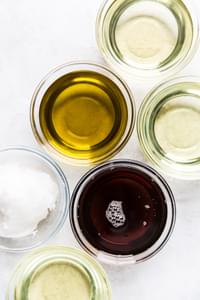Pantry Essentials: The TMP Guide to Cooking Oils
A shimmering pool of hot oil in your favorite pan vibrates with viscous possibility. Whether you’re about to make an elaborate Thanksgiving dinner for 20 of your closest friends, or just fry yourself an egg, all great meals begin with a reach for cooking oil. But which one to reach for? What type of oil should you use? As cloudy and white as freshly fallen snow, or as bright and golden as a just-setting sun, cooking oils vary as much in flavor and purpose as they do in hue.
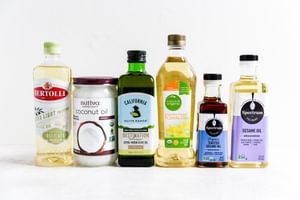
Olive Oil
Ranging in flavor from buttery and sweet to tannic and almost-bitter, olive oil is one of the most familiar cooking oils, but it’s often misused and misunderstood. And that’s not so surprising, when you consider the fact that the wide world of olive oil is a lot like that of wine: vast, complex, and pretty darn confusing. Luckily, we’re here to set the record straight!
What Olive Oil Should I Buy for Cooking?
When it comes to selecting a cooking oil, there are a few things to consider. Consider the oil’s “smoke point”, or the temperature at which an oil starts to burn and to give off smoke. Typically, the more refined an oil is, the higher the smoke point. In the case of olive oil, different olive oils have different smoke points—there are three main categories of olive oil you’re likely to encounter, and we explore them in depth below.
Also worth knowing is that olive oil labeling is not as strictly regulated in the U.S. market as it is in other parts of the world—it’s not unusual to find something labeled “extra virgin olive oil” that is actually not that at all. So, buyer beware! Marketers and food producers will happily slap an “extra virgin” label on a bottle of olive oil—and the price tag that goes with it—without delivering you a truly high-quality product. Crime! Intrigue! The story of olive oil fraud is a fascinating one that you can read up on here, if you want to know more.
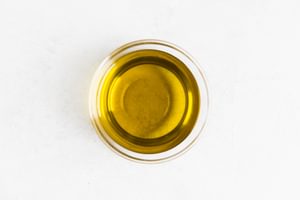
The best we can do is be informed shoppers, and know (at least) what the labels are supposed to mean. Olive oils sold in the U.S. are usually labeled either:
- Virgin olive oil: in other words, unrefined olive oil. According to the International Olive Oil Council, virgin olive oil is “obtained from the fruit of the olive tree solely by mechanical or other physical means under conditions, particularly thermal conditions, that do not lead to alterations in the oil, and which has not undergone any treatment other than washing, decantation, centrifugation and filtration.”
- Extra virgin olive oil: just as it sounds, the classification “extra virgin” indicates an additional level of quality, above “virgin” oils. Extra virgin oils should have a lower acidity than those merely labeled “virgin”, and therefore an even more desirable flavor. They’re the best of the best. Extra virgin olive oils from different regions and made from different olive varieties will have vastly different flavors—have fun exploring them and see which ones you prefer! Virgin and extra virgin olive oils are what you want to reach for when you’re not so worried about smoke point—use them to make ultra-delicious vinaigrettes, or pour a drizzle on top of a finished dish for a bright hit of richness and flavor.
- "Extra Light Tasting" or “pure” olive oil: “light” olive oil is light in color (not calories). Chemically refined, it has a higher smoke point than its virgin and extra virgin counterparts, so it’s the one you want to have on hand for higher-heat cooking. A good-quality light olive oil is also a great alternative to extra virgin for mixing up more mildly-flavored dressings and marinades.
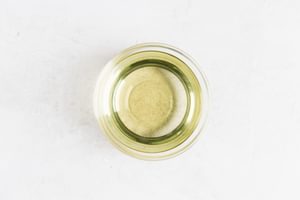
How to Use Extra Virgin Olive Oil:
A hunk of good, fresh crusty bread is all a terrific extra virgin olive oil needs. But, we love to pour it on just about everything. Here are a few of our favorite olive oil-centric recipes:
- Fruity, vibrant extra virgin olive oil shines in fresh pesto, and this Heirloom Tomato BLT with Pesto has us asking—us it summer yet?
- Chimichurri Marinated Shrimp is a great example of a recipe that would work as well with light olive oil—if you prefer a more delicate flavor—as it would with extra virgin.
- Our cheery Spring Salad with Barley and Lemon-Chive Vinaigrette would shine with either olive oil, too! Extra virgin would lend major punch to the dressing, while light olive oil would let the mustard and lemon juice do the talking.
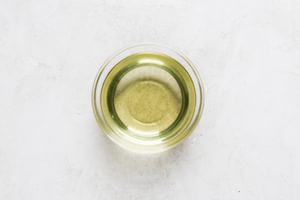
Canola Oil
When we think canola oil, we think about stir-fries, high-heat cooking, moist pound cakes, and our Grandma’s kitchen cupboards (where it sat in a place of honor, always). There’s something comfortingly old-fashioned about it, and we know for sure that a kitchen pantry just isn’t complete without it. But we do have one question:
What is Canola Oil?
Um, yeah. But seriously. What is this stuff that we’ve been cooking with for all these years? What is a “canola”? Here’s the run-down:
- Canola is a plant! Thus, canola oil is a type of vegetable oil.
- The term “canola” is a hybrid of “Canada” (where the canola plant was bred) and “oil”.
- Canola plants are in the brassica genus of plants, along with broccoli, cauliflower and kale.
- Although not quite as healthy as olive oil, canola oil is also relatively high in monounsaturated fats.
- Congratulations! You’re basically a canola oil expert now.
Why We Love It:
Neutral flavor and a high smoke point make canola oil a super versatile cooking oil, one that we seem to reach for again and again. Like we mentioned earlier, it’s perfect for making meals that require high heat (like stir-fries) and it’s great for baking as it adds moisture and fat without altering flavor.
- A lot of granola recipes call for butter, which—and don’t get us wrong, we love a little butter—seems like a bait-and-switch. Isn’t granola supposed to be good for you? So we make our Granola with canola oil instead! A perfect choice for a situation like this that demands a little fat, but doesn’t need any additional flavor.
- Likewise, canola oil is the secret to super-moist loaf cakes, like this easy, fluffy Gingerbread Loaf.
- Salsa Verde has plenty going on—it demands a neutral oil with a high smoke point. Canola oil to the rescue!

Sesame Oil
If you’re ever, at any time, planning to cook Asian food, you are going to need sesame oil. Extracted from sesame seeds—either toasted or not—sesame oil is a pillar of most Asian cuisines. Nutty and rich, it adds flavorful depth to so many of our favorite marinades, stir-fries, and dipping sauces.
Sesame Oil: Toasted vs. Untoasted.
Labels that mean exactly what they say? Could it be true? In the case of sesame oil—yes! Toasted sesame oil is oil that is extracted from toasted sesame seeds, so it is more strongly flavored than its untoasted counterpart. Untoasted sesame oil, however, has a high smoke point, so it’s your best bet if you want to use it as a cooking oil in a high-heat situation, like a stir-fry. Both toasted and untoasted are great, and have their place, but there’s no need to stock both. We usually keep toasted sesame oil stocked in our pantries, but it’s really up to you which one you want to keep around. Typically we’ll cook a dish—like a stir-fry—using canola oil for the initial fry, and we’ll finish it (after taking it off the heat) with a drizzle of toasted sesame oil for flavor. If you prefer a milder sesame flavor, though, go for the untoasted kind!
What Can Sesame Oil Be Used For?
Stir up a simple Asian-inspired salad dressing, or drizzle some on a big bowl of noodles—sesame oil brings a big dose of fragrance and deliciousness to so many things. Here are a few of our favorite uses for it:
- Mix up a simple Asian-inspired vinaigrette by combining rice vinegar, sesame oil (we like toasted sesame oil here), and soy sauce. Just toss with your favorite lettuce and gobble.
- Salmon and sesame oil are a killer combo, and we’re especially fond of them in this 30-Minute Garlic-and-Ginger Salmon Dinner.
- This satisfying, veggie-packed Broccoli Beef Soba Bowl is a great example of how essential the flavor of sesame oil is to Asian cuisine.

Coconut Oil
Coconut oil. It’s so hot right now. We’re slathering it all over our hair and mixing up coconut oil-based face masks, AND we cook with it, too! Is there anything this stuff can’t do? We all have a big jar of this in our pantries these days, right? And it completely deserves to be there! And not just because it makes your skin look so good. It’s also excellent for cooking with. But before we get into that, there’s an elephant in the room that we need to address.
Is Coconut Oil Good for You or Not?
If only there was a simple answer to this question, but there just isn’t. Coconut oil is a saturated fat, and eating a lot of those is without question associated with an increased risk of heart disease. But! Everything in moderation, right? Plus, as far as these kinds of fats go—solid, saturated fats that are solid at room temperature—it is a less-processed choice than many of its counterparts. Unrefined, or “virgin” coconut oil is a great choice if you’re looking for a coconut oil with a lovely coconut scent, while refined coconut oil is what you want to use if you want a neutral flavor and a slightly higher smoke-point. Plus you already have it in your pantry for all those magical, skin-beautifying reasons, right?
How to Use Coconut Oil
- Coconut oil stands in for butter in this rich and warming Apple and Maple Baked Oatmeal.
- Sweet potato casserole doesn’t have to be unhealthy, and our ginger-scented Healthy Sweet Potato Casserole is here to prove it.
- Virgin coconut oil lends a hint of the tropics to this roasty, toasty Nuts and Seeds Granola.
